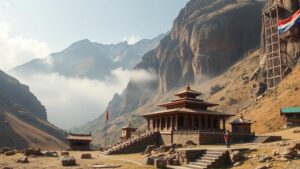Lessons learned from researching and visiting over 35 lost cities worldwide.
Lessons Learned from Researching and Visiting Over 35 Lost Cities Worldwide
The quest for lost cities has captivated adventurers, historians, and archaeologists for centuries. From the dramatic ruins of Machu Picchu in Peru to the enchanting city of Petra in Jordan, exploring these once-thriving civilizations offers profound insights into the human experience. Drawing from my research and visits to over 35 lost cities around the globe, this article summarizes the key lessons learned from these remarkable experiences.
1. Importance of Contextual Knowledge
One of the primary lessons learned is the necessity of understanding the historical and cultural context of each site. For example, the ancient city of Angkor Wat in Cambodia not only serves as an architectural marvel but also tells the story of the Khmer Empire’s influence in Southeast Asia from the 9th to the 15th centuries.
- Visiting Angkor Wat without understanding Hindu and Buddhist influences would obscure the meaning of its detailed carvings.
- Engaging with local historians provides an essential narrative that enriches the visit.
2. Preservation Challenges
Throughout my travels, I observed that many lost cities face immense preservation challenges. city of Pompeii in Italy, famously buried by the eruption of Mount Vesuvius in 79 AD, illustrates the ongoing battle between nature and mankind’s need to preserve history. The combination of natural erosion and tourist impacts threatens the remnants of this once-bustling city.
- Statistically, Pompeii sees over 2.5 million visitors each year, raising concerns about sustainable tourism.
- Efforts like using biodegradable materials for walkways are vital to protecting fragile structures.
3. Archaeological Significance
Many lost cities hold keys to understanding ancient societies. For example, the discovery of the city of Troy in Turkey provided powerful evidence for the historical backdrop of Homer’s epic, the Iliad. Excavations revealed structural and material data that have reshaped the comprehension of trade and warfare in the ancient world.
- Excavations at Troy unearthed artifacts that date back to 3000 BCE, showcasing extensive trade networks.
- Similar discoveries at the Indus Valley Civilization highlight advanced urban planning and sanitation systems, dating back to 2500 BCE.
4. Cultural Legacy and Influence
The influence of lost cities extends far beyond their physical remnants. For example, the Inca Trail leading to Machu Picchu is not just an architectural journey but also a pilgrimage that reflects the spiritual and cultural values of the Incan people. The legacy of these civilizations informs modern cultural practices and beliefs.
- In Andean culture, the reverence for Pachamama (Mother Earth) is deeply rooted in the agricultural practices that thrived around lost cities.
- Similarly, the vibrant traditions around the ruins of Chichen Itza in Mexico connect contemporary life to its Mayan roots.
5. Resilience of Humanity
A common thread among lost cities is the resilience of the civilizations that built them. rise and fall of civilizations, such as the Aztecs in Tenochtitlán, highlight humanitys ambition and adaptability. Despite challenges such as disease, invasion, or natural disasters, human creativity and innovation have spawned magnificent architectural feats.
- The Aztec capital, established in 1325, showcased advanced engineering with its canal systems and floating gardens, demonstrating an extraordinary adaptation to the environment.
- Today, the remnants serve as a testament to the ingenuity of past societies amidst their struggles.
6. Economic and Environmental Lessons
Researching lost cities has also illuminated significant economic and environmental lessons. Many civilizations failed to mitigate the environmental impacts of their growth. The Mayans, for instance, faced deforestation and soil degradation, which contributed to their societal decline.
- This underscores the importance of sustainable practices, particularly as modern populations grow and urbanize.
- Drawing parallels between ancient practices and current environmental issues can guide future actions for sustainability.
7. Engaging with Local Communities
Lastly, connecting with local communities surrounding lost cities is invaluable. residents often serve as custodians of the history and offer insights often not available in mainstream narratives. In the case of the ancient city of Machu Picchu, local guides provide enriching stories that connect the history of the site to the present-day Indigenous culture.
- Promoting local voices fosters respect for heritage and nurtures community-led conservation efforts.
- Tourists benefit from learning authentic cultural perspectives that deepen their understanding of the sites they visit.
Conclusion
Researching and visiting over 35 lost cities has yielded profound lessons on history, culture, and the existential narrative of humanity. By prioritizing contextual knowledge, understanding preservation challenges, and valuing local community insights, we can foster a deeper appreciation for our shared past. e experiences also impart vital lessons on sustainability and resilience that resonate in our contemporary lives. As we continue to explore our world, we must remember that the story of lost cities is also a story of humanitys journey–its failures, triumphs, and enduring spirit.


